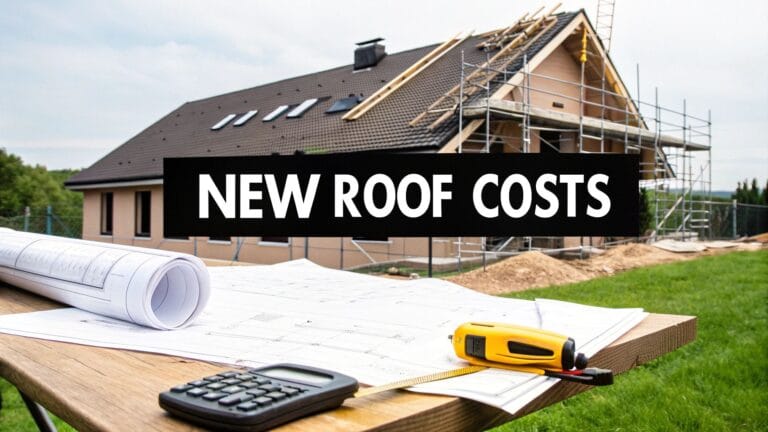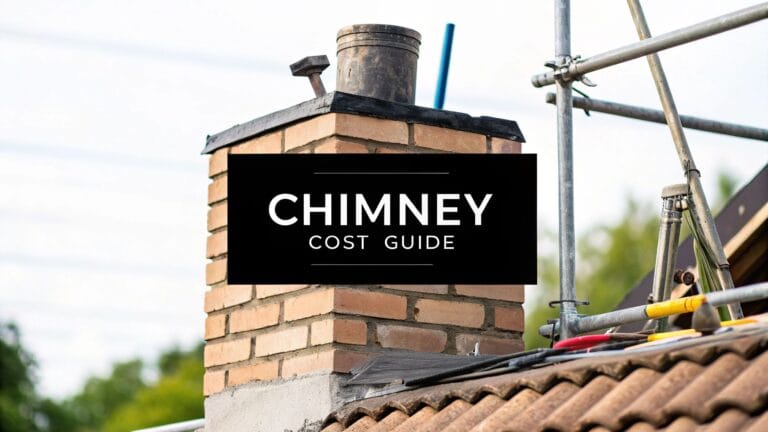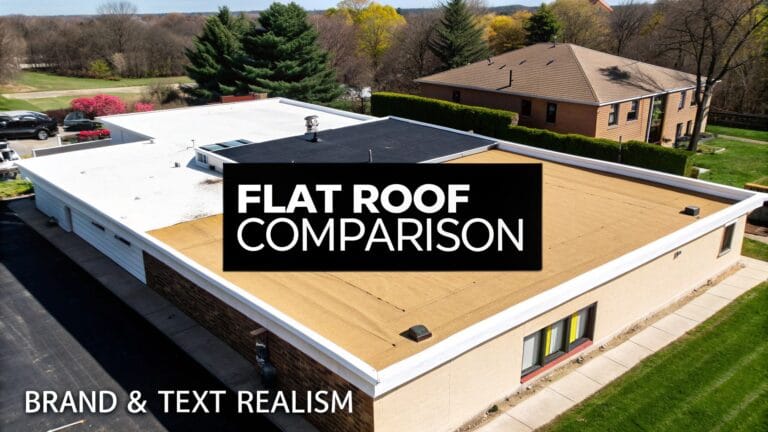
UK Flat Roof Repairs Cost Your Complete Guide
Thinking about flat roof repairs cost? This guide breaks down UK prices for felt, GRP, and EPDM, with actionable tips for Buckinghamshire homeowners.
Trying to figure out what a flat roof repair is going to set you back can feel a bit like guesswork. As a rule of thumb, you can expect a typical repair in the UK to fall somewhere between £45 and £120 per square metre. This gives you a decent ballpark figure for budgeting before you start getting detailed quotes.
Your Guide to Flat Roof Repair Costs in Buckinghamshire
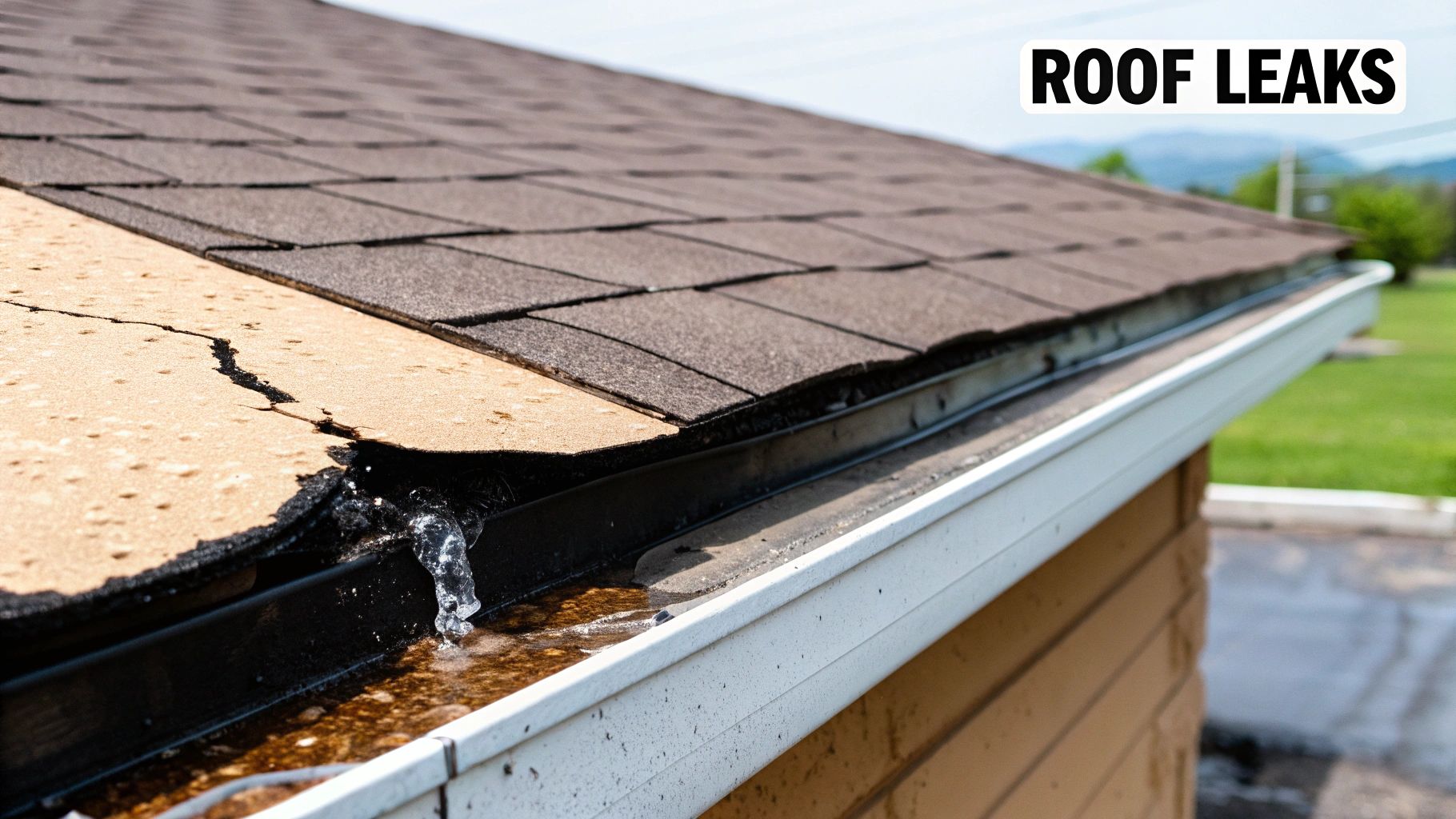
The moment you spot a damp patch on the ceiling or notice wear and tear on your flat roof, the first question that pops into your head is almost always, "How much is this going to cost?" Getting a handle on the potential expense is crucial, as it helps you act fast before a small drip turns into a full-blown disaster.
While the national average is a useful starting point, costs can vary quite a bit depending on where you are in the UK, the type of damage you're dealing with, and the materials needed for the job.
Here in Buckinghamshire, we at Evershield Roofing have seen it all. From tiny tears in old felt to more serious issues caused by water ingress, every job is unique. We want to give you a transparent, no-nonsense look at what you can expect to pay, taking the mystery out of the whole process.
Estimated Costs for Common Flat Roof Repairs in Buckinghamshire
To give you a better idea, we've put together a quick overview of typical price ranges for specific, common flat roof repairs we carry out. This should help you budget for those more minor issues.
| Type of Repair | Average Estimated Cost (Incl. Labour) |
|---|---|
| Minor Leak Patching (e.g., small tear) | £150 – £300 |
| Repairing Blisters or Bubbles (per area) | £200 – £400 |
| Flashing Repair or Replacement (per metre) | £60 – £120 |
| Gutter or Drainage Unblocking and Repair | £100 – £250 |
| Small Section Resurfacing (under 5m²) | £250 – £500 |
It's worth noting that experience tells us most flat roofs, especially older felt systems, start needing repairs around the 10 to 15-year mark. That's when issues like leaks and ponding water tend to show up.
Remember, these figures are just estimates. The final price tag will always depend on specific factors that we’ll dive into next, like how easy it is to get onto your roof and the state of the structure underneath.
This guide will walk you through everything that influences your final bill. By understanding what drives costs up or down, you'll be in a much better position to assess quotes from roofing companies like ours and make a smart choice for your home.
For a more detailed breakdown, you can always explore our complete guide on flat roof repair costs. In the following sections, we’ll unpack exactly what goes into these prices so you have all the information you need.
What Goes Into Your Repair Bill?
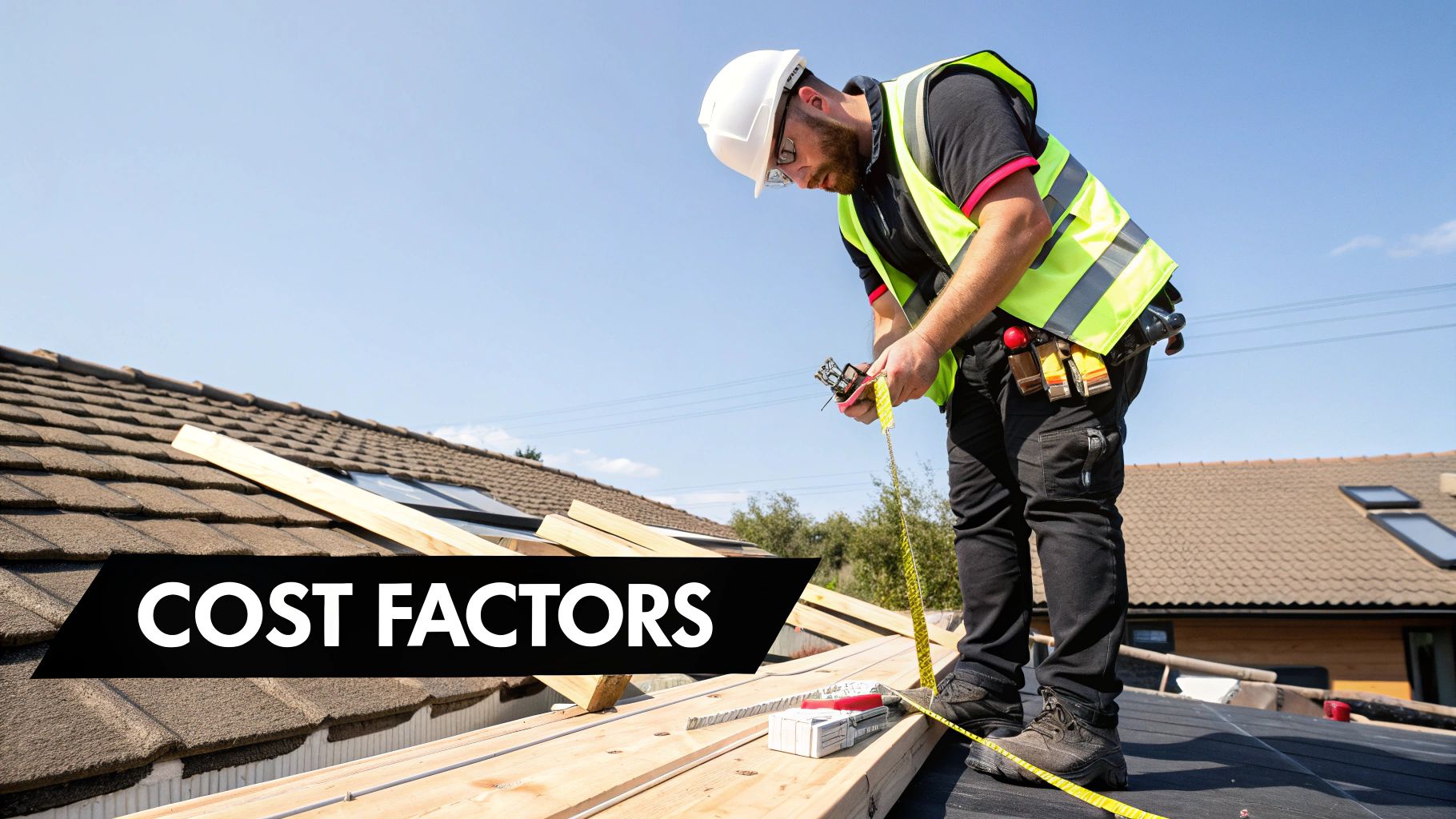
So, you’ve got a few quotes for your flat roof repair, and the prices seem to be all over the map. What gives? It's a common question, and the answer is that the final figure isn't just pulled out of thin air. It’s a careful calculation based on several key variables that can completely change the scope of the job.
Think of it like a trip to the car mechanic. A routine oil change is quick and predictable. But if the mechanic finds a worn timing belt or a leaking head gasket, the job suddenly gets a lot more complex and expensive. Your flat roof is exactly the same. The initial symptom—a small leak—might just be the tip of the iceberg, hiding a bigger problem underneath.
At Evershield Roofing, we believe in being upfront about costs. When you understand these factors, you can read a quote with confidence and know precisely what you're paying for.
The Type of Roofing Material
The first thing that has a major impact on your flat roof repair cost is the material itself. Different surfaces demand unique techniques, specialist tools, and varying levels of expertise to fix properly. It’s a bit like comparing a stonemason to a carpenter—both are highly skilled, but their materials and methods are worlds apart.
Here are the most common materials we come across in Buckinghamshire:
- Traditional Felt: While it's a budget-friendly option, felt repairs can be tricky. Applying heat with a torch requires a steady hand and real precision to get a perfect seal without accidentally creating new weak spots.
- EPDM Rubber: Known for its fantastic durability, EPDM is usually repaired using special tapes and adhesives. The materials themselves might cost a bit more, but the repair process is often much faster than working with felt.
- GRP Fibreglass: A GRP or fibreglass roof is essentially a seamless, hard shell. Repairs involve sanding down the damaged area and carefully applying new layers of resin and matting, which is a meticulous, multi-stage process.
The material doesn't just dictate the labour time; it also affects the cost of the specific repair kits and products needed to do the job right.
The Size and Extent of the Damage
This one might sound obvious, but it’s easily the biggest driver of cost. A small, isolated tear in the roof's membrane is a pretty straightforward patch job. If water has been seeping underneath for months, however, the problem goes much deeper.
Imagine spilling a glass of water on a wooden table. Wipe it up quickly, and you're fine. But if that water sits overnight, it can warp the wood and ruin the finish, meaning you now have to sand it all down and refinish it.
The same principle applies to your roof. A surface-level issue is a minor fix. But once water gets past that top layer and starts to compromise the timber deck below, the repair becomes a structural one. This involves stripping back the roof covering, cutting out and replacing rotten timber, and then rebuilding the roof surface.
This is where costs can climb significantly. It demands more materials, more labour, and a great deal more expertise to restore the roof's structural integrity.
Roof Accessibility and Location
How easy is it for our team to actually get onto your roof? A flat roof on a ground-floor extension or a garage is usually simple to access. But a roof on a second or third storey, or one hemmed in by other buildings, presents a real logistical challenge.
Safe access is completely non-negotiable. If we can't use ladders safely and securely, then scaffolding will be required, which adds a separate and significant cost to the project. This is a crucial safety measure that protects both our team and your property.
When you're planning any kind of home improvement, including roof repairs, it's always a good idea to consult a comprehensive home renovation checklist. It can help you think through things like budgeting and hiring professionals, which are directly relevant here.
At the end of the day, a simple patch on an easily accessible garage in Aylesbury will cost far less than repairing extensive water damage on a hard-to-reach dormer in High Wycombe. By understanding these core factors, you’ll be much better equipped to interpret any quote and have a productive chat with our team.
Repair or Replace? Comparing Material Costs
When your flat roof starts leaking, you're faced with a big decision: do you patch it up, or is it time for a full replacement? This isn’t just about stopping the drip; it's about making a smart financial move for the long run. The right answer often hinges on the type of material on your roof and how much life it has left in it.
Think of it like an old car. A quick, cheap fix might get you back on the road for now, but if you’re constantly calling the garage, you’ll soon wish you’d just invested in a reliable new motor. We see this exact scenario play out with flat roofs across Buckinghamshire all the time.
At Evershield Roofing, we help homeowners weigh the immediate flat roof repair cost against the long-term value of a replacement. It all starts with understanding the materials.
Felt vs EPDM vs GRP: A Quick Breakdown
In the UK, the flat roofing world is dominated by three main materials. Each comes with its own price tag, performance, and lifespan, and knowing the difference is crucial.
- Traditional Felt (Torch-on): This is the classic, most budget-friendly option you'll see. While it does the job, felt has the shortest lifespan. Over time, it can become brittle, leading to cracks and blisters that need regular attention.
- EPDM Rubber: A modern, incredibly durable single-ply membrane. EPDM is famous for its flexibility and ability to withstand extreme weather, making it a fantastic mid-range choice with a very long service life. Repairs are usually quite simple, too.
- GRP Fibreglass: Standing for Glass Reinforced Plastic, GRP creates a completely seamless, waterproof, and rock-solid surface. It has the highest upfront cost, but it also offers the longest lifespan and is phenomenally resistant to damage.
Choosing the right path forward really depends on your budget, how long you plan to be in your home, and how much future maintenance you’re prepared to deal with. For a deeper dive, you can explore our detailed comparison of the best roofing materials for flat roofs.
The chart below shows how repair costs can quickly escalate with the size of your roof, giving you a clearer picture of the potential expense.
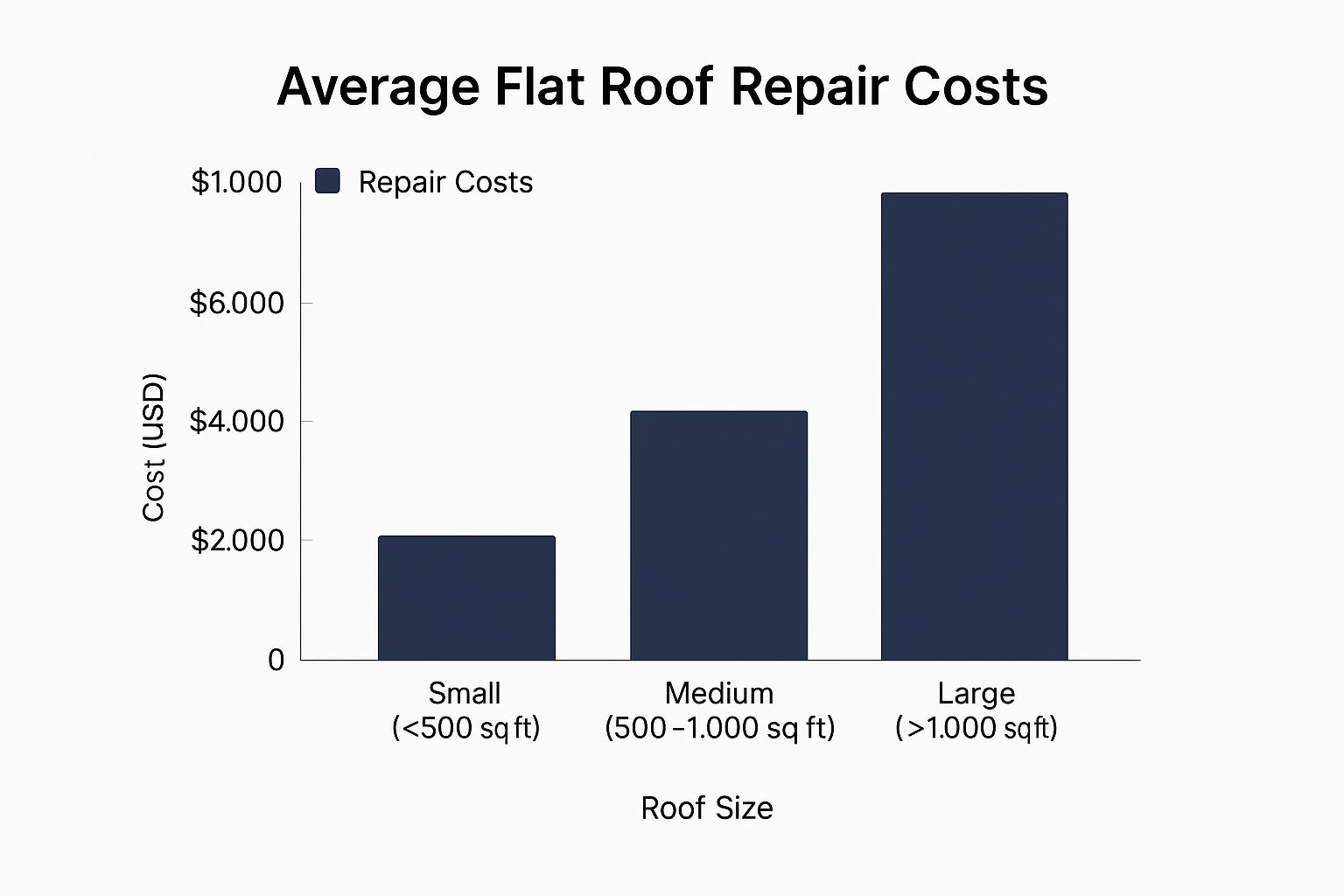
As you can see, the cost of repairs really climbs as the roof area gets bigger. It’s a powerful reminder of why catching problems early, especially on larger roofs, is so important.
The Long-Term Financial Picture
Let’s talk numbers. While a simple patch-up on a felt roof might only set you back a few hundred pounds, a full replacement is a much bigger investment. Across the UK, the cost to replace a flat roof generally lands somewhere between £70 and £150 per square metre, once you factor in all the labour and materials.
For instance, a new torch-on felt roof might be around £70–£100/m² and give you up to 15 years of service. On the other hand, a high-performance GRP fibreglass system could be anywhere from £100–£150/m² but is built to last for 25 years or even longer.
This is where the real calculation comes in. A cheap repair might look good on paper today, but if you’re calling a roofer out every few years, those costs stack up fast. Investing in a durable replacement like GRP could mean you don’t have to worry about it again for decades, ultimately saving you a significant amount of money and stress.
To make this crystal clear, let's put these materials side-by-side.
Cost and Lifespan Comparison of Flat Roof Materials
This table breaks down the typical costs and lifespans for the three most common flat roofing materials, helping you see the trade-offs at a glance.
| Material Type | Average Replacement Cost per m² | Expected Lifespan | Typical Repair Complexity |
|---|---|---|---|
| Felt (Torch-on) | £70 – £100 | 10-15 years | Moderate (Requires heat application) |
| EPDM Rubber | £90 – £130 | 20-30 years | Low (Often uses adhesives/tapes) |
| GRP Fibreglass | £100 – £150 | 25-40 years | High (Requires skilled layering) |
The pattern is clear: lower-cost materials have shorter lifespans, meaning you’ll be facing that replacement bill much sooner. The premium materials might cost more upfront, but they deliver decades of peace of mind and often provide far better value over their lifetime.
How to Spot Flat Roof Problems Early
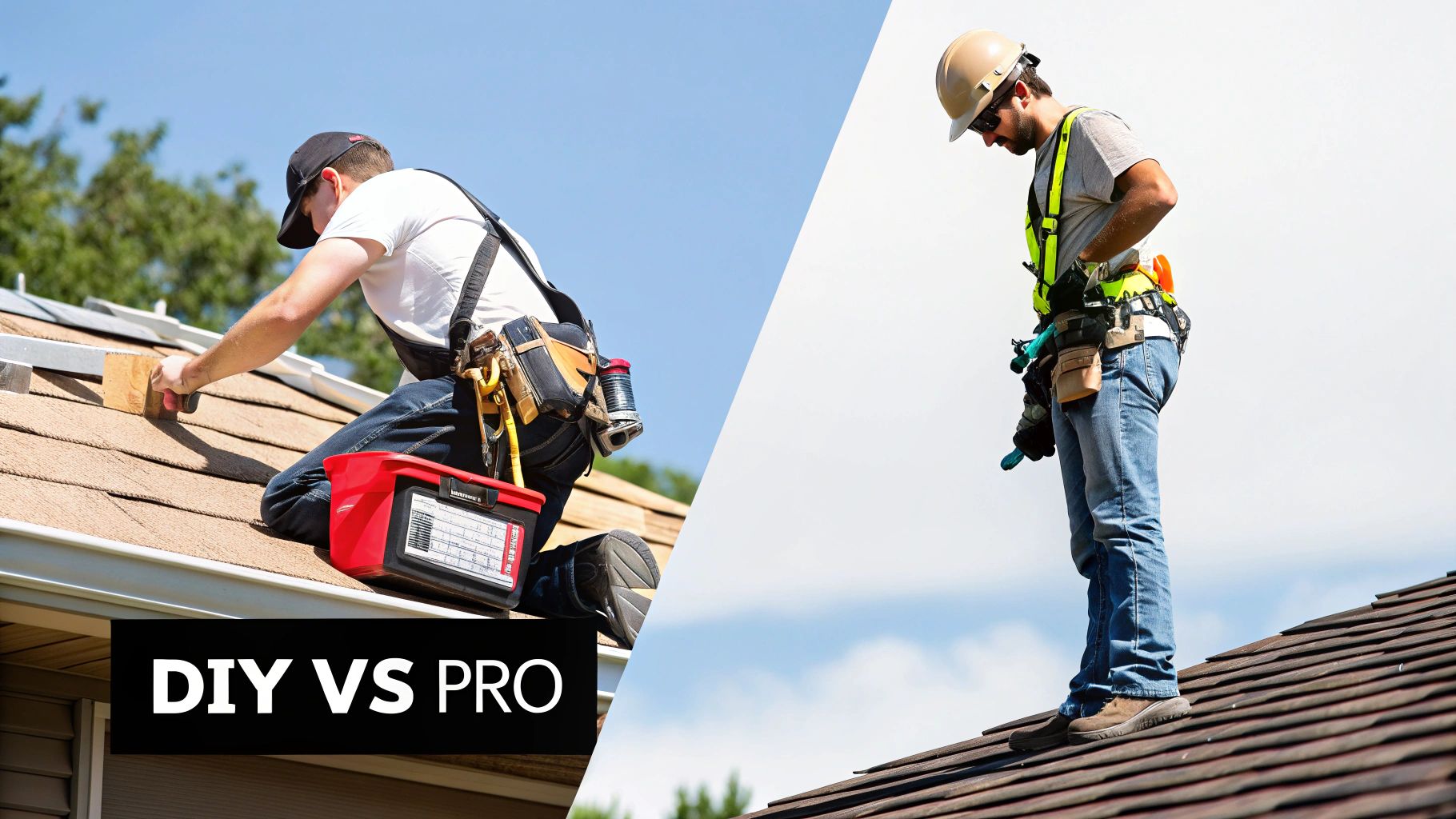
Catching a small problem before it turns into a major disaster is the single best way to manage your flat roof repairs cost. It’s a bit like a tiny chip in a windscreen; ignore it, and a sudden cold snap can send a huge crack right across the glass. Your roof is no different, and a bit of vigilance now can genuinely save you thousands down the line.
Too many homeowners in Buckinghamshire only realise they have a problem when a damp patch appears on the ceiling. By that point, the water has already found its way through multiple layers. The real trick is learning to spot the subtle warning signs on the outside.
This isn’t about you clambering onto the roof – leave that to professionals like us at Evershield Roofing. Safety always comes first. It’s about knowing what to look for from a safe spot, like an upstairs window or even from the ground with a pair of binoculars. A quick check a few times a year, especially after a heavy storm, makes all the difference.
The Most Common Warning Signs
Keep an eye out for these classic signs that your flat roof is in trouble. Each one is a clear signal that something needs professional attention before it escalates.
1. Ponding Water
This is the technical term for puddles that just won't go away. If you see pools of water still sitting on your roof more than 48 hours after it has rained, that’s a red flag. A properly installed flat roof isn't perfectly flat; it has a slight, deliberate slope to guide water towards the drains.
When water stands still, it puts constant strain on the roof. It also acts like a magnifying glass for the sun’s UV rays, which speeds up the deterioration of the membrane underneath.
2. Surface Blisters and Bubbles
These look exactly as they sound: pockets of air trapped just under the roof’s top layer. They’re usually caused by a tiny amount of moisture getting caught between the roofing layers. When the sun heats the roof, that moisture turns to vapour and expands, pushing the material up into a bubble.
A blister creates a dangerously thin and weak spot on your roof, making it much more vulnerable to splits or punctures that lead to instant leaks.
3. Cracks, Splits, or Tears
Over the years, the constant cycle of heating up and cooling down makes roofing materials lose their flexibility. Older felt roofs are particularly prone to becoming brittle. This eventually leads to visible cracks or splits in the surface.
Don't underestimate a small tear. It can let in a surprising amount of water, which then soaks into your insulation and can even start to rot the timber deck beneath.
Spotting these issues early is critical. A small blister can often be repaired for a modest sum. But if that same blister bursts and lets water rot the decking, you’re suddenly facing a far more complex and expensive structural repair.
Performing Your Own Safe Inspection
You don't need to be a roofer to keep an eye on things. A simple visual check from the ground a couple of times a year is an incredibly powerful habit. If you'd like a more detailed walkthrough, our guide on how to inspect your roof for damage provides some great tips.
If you spot any of these warning signs, please don't put it off. The sooner you call in our professional team, the better the chance of a simple, cost-effective fix. Acting quickly stops a minor issue from snowballing into major structural damage, protecting your home and your bank balance.
A Real-World Repair: From Leaky Roof to Lasting Fix in Buckinghamshire
Theory is one thing, but seeing how a repair unfolds in the real world is often the best way to get a handle on the process and the potential flat roof repairs cost. To lift the curtain on what actually happens when you call us at Evershield Roofing, let’s walk through a recent job we handled for a homeowner in Amersham.
It’s a classic story of a stubborn leak, a bit of detective work, and a solid, cost-effective repair that restored the roof and the owner’s peace of mind.
The First Call: A Damp Patch in the Kitchen
It all began with a phone call. A homeowner was worried about a damp patch that had appeared on their kitchen ceiling. It was situated right under their single-storey extension, which had an old felt flat roof. They’d tried a DIY patch job a year ago, but the leak was back, and they were concerned about what kind of damage was happening out of sight.
Our first job was to put their mind at ease. We immediately scheduled a free, no-obligation survey for the next day. Getting there quickly and keeping homeowners in the loop is central to how we work; it helps stop the problem—and the anxiety—from getting any worse.
The On-Site Inspection: Uncovering the Real Culprit
When our technician got to the property, a quick look from the ground didn’t show any obvious holes or tears. That’s actually quite common. The spot where water gets in is rarely directly above where the damp shows up inside. So, using proper safety gear, he got up onto the roof to take a much closer look.
It didn't take long to find the true source of the problem. The flashing, which is the waterproof seal where the flat roof joins the main house wall, had started to fail and pull away. This had opened up a tiny, almost invisible gap, letting rainwater seep down the wall and into the roof’s structure.
Here’s exactly what the inspection revealed:
- Failed Flashing: The old lead flashing was cracked and had lifted, completely breaking the weatherproof seal.
- Saturated Insulation: We took a small core sample and found the insulation underneath the felt was soggy, meaning it wasn't doing its job of keeping the heat in.
- Solid Decking: The good news was that the timber deck underneath was still perfectly sound, with no signs of rot.
This find was absolutely critical. If the homeowner had just slapped another patch on the roof surface, the real issue would have been missed. The leak would have returned, and the eventual repair bill would have been much, much higher. A thorough inspection is the only way to get to the root cause.
The Repair Plan and a Clear, Honest Quote
With a proper diagnosis in hand, we could give the homeowner a detailed, itemised quote. The best part? We explained that a full roof replacement wasn't needed, which came as a huge relief. While some problems are major, many homeowners are pleasantly surprised to learn that a targeted, professional repair is all it takes.
In the UK, replacing even a small flat roof can often cost between £1,500 and £2,500, so our goal is always to avoid that bigger expense if we can. For anyone interested, you can find more detailed pricing information on UK roof replacement costs on rbg-ltd.co.uk. Our quote, however, was focused solely on fixing the problem at hand.
Here was our step-by-step plan:
- First, we’d carefully strip back the felt roofing in the section adjoining the house.
- Next, we'd remove all the wet, damaged insulation and let the area dry out completely.
- Then, we’d install new, high-performance rigid insulation to bring the thermal efficiency back up to standard.
- After that, we'd fit brand new lead flashing, chasing it properly into the brickwork to create a permanent, watertight seal.
- Finally, we’d re-felt the repaired area using a high-performance torch-on system, making sure it was seamlessly bonded to the rest of the roof.
The homeowner gave us the go-ahead, and we booked the job in for the next clear weather day. By talking them through every step, they knew exactly what they were paying for and why. They felt informed and in control—and that's how we build trust, one repair at a time.
Your Flat Roof Repair Questions Answered
Trying to get to the bottom of flat roof repair costs can feel a bit overwhelming, but you're definitely not the first to have questions. Most homeowners we talk to across Buckinghamshire have the same queries before they decide to go ahead with a repair. To clear things up, we've put together some straightforward answers to the questions we hear the most.
Think of this as the final piece of the puzzle, designed to give you the confidence to make the right decision for your home.
How Long Will My Flat Roof Repair Take?
One of the first things people want to know is how much disruption they can expect. "How long will you be here?" is a perfectly reasonable question. The answer, much like the difference between changing a car tyre and rebuilding an engine, really depends on the scale of the job.
A simple, small patch on a garage roof where the damage is pretty minor might only take a few hours. On the other hand, if we're dealing with something more complex like replacing rotten timber decking or installing new flashing along a long edge, that could easily take a full day, maybe even two.
To give you a rough idea, here’s what you can generally expect:
- Minor Patching (under 2m²): Usually wrapped up in 2-4 hours.
- Flashing Replacement (per side): This typically takes about half a day.
- Structural Repair (decking/insulation): This is a bigger job and can take anywhere from 1 to 3 days, depending on how bad the damage is and what the weather decides to do.
Of course, we'll always give you a clear and realistic timeline with our quote, so you’ll know exactly what to plan for.
Should I Repair My Old Felt Roof Again or Replace It?
This is a big one, especially for anyone with an older felt roof that’s clearly seen better days. It really comes down to weighing the short-term cost against the long-term benefit. A single repair might seem like the cheaper option right now, but constantly patching things up can quickly become a false economy.
Think of it like this: if your felt roof is over 15 years old and you find yourself calling a roofer to fix a new leak every winter, the total you're spending on those repairs can start to creep up towards the cost of a full replacement. Each patch is just a temporary fix on a system that's fundamentally on its way out.
From our experience on the ground, if a felt roof needs more than two significant repairs within a three-year span, it’s almost always more cost-effective in the long run to replace it with a modern EPDM or GRP system. A brand-new roof puts an end to the cycle of worry and stops those repair bills from piling up.
We’ll always give you an honest assessment. If a solid repair will genuinely give you several more years of service, we’ll tell you. But if we think you’re just throwing good money after bad, we'll explain exactly why a replacement offers much better value.
Are Emergency Call-Out Repairs More Expensive?
Absolutely. When a storm hits and water starts coming into your home, you need someone there fast. Emergency call-outs are a crucial service, but they do cost more than a repair you schedule in advance. The higher price is simply a reflection of getting our team out to you immediately, often outside of normal hours and in horrible weather, to make your roof safe and watertight.
An emergency call-out fee typically covers:
- Immediate Response: Getting a skilled roofer to your property as an absolute priority.
- Temporary Fix: The main goal is to put a temporary solution in place to stop the leak and prevent any further damage to your home.
- Follow-Up Assessment: We’ll then schedule a proper visit in daylight to assess the full extent of the damage and give you a detailed quote for a permanent repair.
While the initial cost is higher, it can save you a fortune by preventing much more expensive damage to your ceilings, walls, and electrics. It’s a necessary investment to protect your property when the worst happens.
What Kind of Guarantee Do You Provide?
A watertight roof is one thing, but peace of mind is another. The guarantee that comes with the work is a huge part of the service. What kind of guarantee you get really depends on the job itself.
For a specific repair, like patching a tear or replacing a small section of flashing, we provide a workmanship guarantee that covers the repaired area. This usually lasts for 12 to 24 months and covers our labour and the materials we used for that particular fix. It’s our promise that the repair we did won’t fail.
For a full roof replacement, the guarantee is far more comprehensive. A new GRP or EPDM roof system installed by us comes with an insurance-backed guarantee that can last anywhere from 10 to 25 years. This covers both the materials and our installation, giving you complete, long-term security in your investment. We always make sure the terms of any guarantee are laid out clearly before we even think about starting the work.
We hope this guide has helped answer some of your biggest questions about flat roof repairs. If you're dealing with a roof issue in Buckinghamshire and need some clear advice and a transparent quote, the team at Evershield Roofing is here to help.

